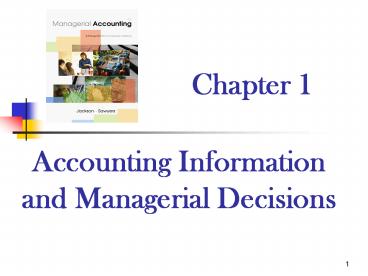Accounting Information and Managerial Decisions - PowerPoint PPT Presentation
1 / 10
Title:
Accounting Information and Managerial Decisions
Description:
Introduction ... May be geared toward specific segments of a company ... Must meet requirements of SEC, GAAP, IRS. 9. A Decision-Making Model ... – PowerPoint PPT presentation
Number of Views:17
Avg rating:3.0/5.0
Title: Accounting Information and Managerial Decisions
1
Chapter 1
- Accounting Information and Managerial Decisions
2
Introduction
DATA- Financial Statements, customer lists,
inventory records, number and type of products or
services sold. INFORMATION - Data that have
been organized, processed, and summarized. KNOWLE
DGE Information that is shared and exploited so
that it adds value to an organization.
3
Introduction
DATA become INFORMATION when organized,
processed, and summarized, and information
becomes KNOWLEDGE when it is shared and exploited
to add value to an organization.
4
Accounting Information
Accounting information includes both financial
and nonfinancial information used by decision
makers.
5
Users of Accounting Information
Financial Accounting
Managerial Accounting
6
Users of Accounting Information
The three primary activities of managers are
planning, operating and controlling
7
The Role of the Managerial Accountant
Managerial accountants facilitate management
decision making.
8
The Information Needs of Internal and External
Users
- Internal Users
- More flexible
- May be geared toward specific segments of a
company - May be customized, less precise, and uses
estimates frequently
- External Users
- Less flexible
- Geared toward reports on company as a whole
- Must meet requirements of SEC, GAAP, IRS
9
A Decision-Making Model
Never make decisions with just the
numbers! Always consider nonnumerical
(qualitative) information.
10
Enterprise Risk Management
- Every business faces risk and uncertainty
- Risk is often thought of in negative terms, but
risk can provide opportunities - Businesses must identify and effectively manage
risks






![[READ] Managerial Accounting For Dummies PowerPoint PPT Presentation](https://s3.amazonaws.com/images.powershow.com/10087166.th0.jpg?_=20240727036)
























